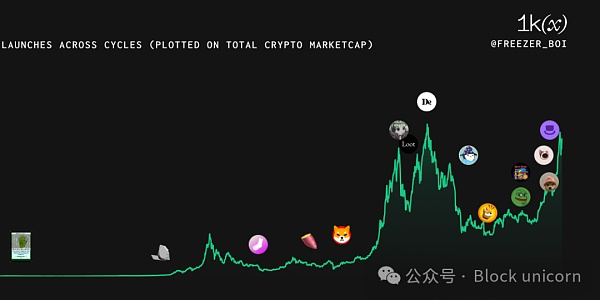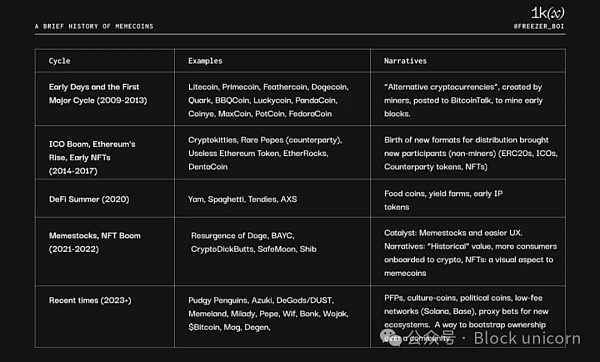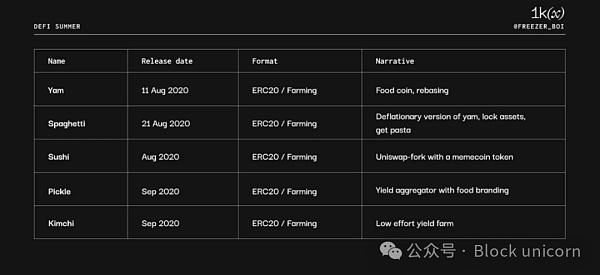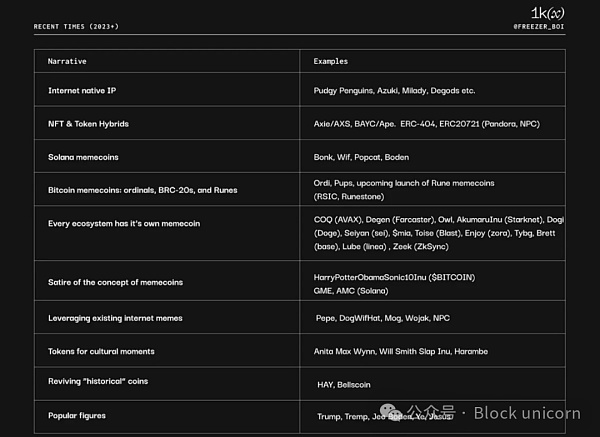Author: Jerome Compiler: Block unicorn

What is a meme?
A "meme" is a unit of cultural ideas and symbols that spreads and spreads in people's consciousness. Like genes, memes vary in their ability to spread. Those that resonate strongly tend to last, while those with less influence are quickly forgotten.
The internet introduced the concept of "internet memes," which facilitate the rapid spread of memes and cultural ideas through images, videos, GIFs, and jokes. One study likened the spread of internet memes to a disease, stating that "memes spread in a manner similar to diseases spread by the SIR model," infecting "individuals."
The spread of online memes is similar to the spread of infectious diseases.

"Memecoins" are cryptocurrencies whose value is derived entirely from the associated meme. Essentially, they bring economic value to the concept of a meme.
With the advent of memecoins, cultural ideas, symbols, and their spread can be traded and speculated. Their value is based on the relevance of memes and their ability to capture public opinion, creating a new market that can quantify cultural resonance and have financial value.
A Brief History of Meme Coins
The following table and chart briefly outline cryptocurrency cycles and the meme coins that have risen during these cycles:


POW Meme Coins
All of these coins died except Litecoin (due to low volume and market cap, lack of exchange support, susceptibility to 51% attacks, etc.). This can be attributed to several factors: weak meme stickiness (lack of cultural permanence) and participation cost issues (each memecoin is a full blockchain).
Litecoin's enduring popularity can likely be attributed to its meme value derived from Bitcoin (digital silver), its earlier appearance compared to other memecoins, and its continued support from numerous exchanges.
Dogecoin: The First Meme Coin
In the summer of 2013, the original Dogecoin ("Wow, Applause") began to spread on 4chan and Reddit. On December 8, 2013, Jackson Palmer and Billy Markus took advantage of this cultural trend and launched Dogecoin on Bitcointalk. It was the first cryptocurrency based on an Internet meme.
The success of Dogecoin has spawned a new category of cryptocurrencies that are fun, humorous, ironic, use celebrities (e.g. Kanye West, Max Keiser), animals (e.g. Pandacoin), or are designed to appeal to a specific community. These were launched as proof-of-work tokens on the "Alternative Cryptocurrencies" sub-forum of Bitcointalk. The "technical details" became less important; everything was centered around the "meme". The image below shows some examples: ICO Craze and the Rise of Ethereum The rise of Ethereum triggered a wave of innovation, bringing new use cases, better user experience, and new users.
Some specific improvements include:
Easier token issuance (ERC20 standard)
Attracted new user groups (non-miners)
Token creators can make more money (unlike zero pre-mine PoW tokens, ERC20 is sold directly through ICO)
left;">Introducing interoperability/unified ecosystem/unified wallet (via ERC20)
The ICO era spawned a wave of more "serious" projects like theDAO, Filecoin, Tezos, EOS, Cardano, Tron, and Bancor that aimed to have utility or purpose beyond meme value. During this period, there were a few memecoins that weren't particularly notable but still attracted some attention.
One example was the Useless Ethereum Token, which launched in June 2017 and mocked the concept of an ICO and raised 310 ETH in its ICO.
Despite Dentacoin's original goal of being a "cryptocurrency for dentists", it was still considered a memecoin and reached a peak market cap of $2 billion in January 2018.
HAYCOIN was the first ERC20 token to be listed on Uniswap and one of the memecoins created in this era (2018). It was created by Uniswap founder Hayden Adams to test the Uniswap protocol and did not initially attract much attention or trading volume, but has re-emerged in 2023 due to its historical significance.

Collectible memes and early NFTs
In addition to cryptocurrencies, a subset of Pepe the frog memes called "Rare Pepes" has appeared. This subset has not been released publicly. If it is leaked, it will be watermarked with "RARE PEPE DO NOT SAVE".
Between 2016 and 2018, a group of Counterparty developers and Pepe meme enthusiasts created the Rare Pepe Wallet (Pepe Cash), with plans to trade “Rare Pepé memes” on the Counterparty protocol.
Rare Pepes are often considered the second series of NFTs ever created, and still have value to this day, with some selling for over $500,000.
With the release of CryptoPunks, MoonCats, and CryptoKitties, NFTs entered the Ethereum era, representing unique tokens pointing to images and media. EtherRocks started as a joke on Reddit in 2017, a collectible themed around collecting 100 colorful clipart rocks, which became popular in 2021, hitting a floor price of 305 ETH (worth $1 million) in August.
Another example is Unisocks (SOCKS), launched by Hayden Adams in May 2019, offering 500 pairs of physical socks that are interchangeable with SOCKs (ERC20). The price of each pair of socks has soared to $53,000, potentially making them the most expensive socks in the world.

DeFi Summer
In June 2020, Compound Finance launched a new token distribution method called "liquidity mining" or "yield farming", where users provide liquidity and earn token rewards by locking assets.
This innovation kicked off the "DeFi Summer", and at its peak, the "foodcoin" yield farm offered to lock tokens in Yam or Pickle contracts to earn 10,000% annualized returns (in memecoin).

Meme Stocks and Dogecoin
In 2021, stimulus measures, interest rate cuts, cheap capital, and COVID-19 lockdowns created a high-risk environment around the world.
Retail traders on Reddit popularized the "Gamestock" meme in early 2021, driven by Robinhood's user-friendly experience and zero-commission trading, causing its stock price to soar rapidly. The craze for "GME" has sparked speculation on other assets, especially those available on Robinhood. DOGE was listed on Robinhood at $0.008 in 2018 and gained attention in 2021 due to Elon Musk's tweets, reaching a peak market value of $90 billion in May 2021. The popularity of DOGE spawned more dog-themed meme coins, such as Shiba Inu, Floki, and Safemoon, which reached high valuations within a few months.

NFT craze: “Meme coins with pictures”
ERC721 standard and platforms such as OpenSea gave birth to NFTs, which are unique crypto assets that represent “cultural” or “memetic” expressions.
Famous NFTs include CryptoPunks, Bored Apes, Squiggles, and Pudgy Penguins, which are used as profile pictures on Twitter and Discord, symbolizing status and "club membership."

Recent Trends (2023+)
As cryptocurrencies rebound from the bear market, new memes, cultures, ideas, and ecosystems continue to emerge, and memes are attracting more and more interest and attention.

Common Patterns
Some form of memecoin emerges in every cycle, in various technical forms such as PoW coins, ERC20 tokens and NFTs, using attention, narrative and hype to survive and spread.
Memes come before tokens; the most successful memecoins leverage existing meme popularity for promotion.
Crypto-native memes are just beginning to spread outside of crypto circles, such as Pudgy Penguins.
Low prices attract speculation; the price itself becomes a meme.
Strong communities and marketing are critical to the success of memecoins.
Memecoins are also evolving from crazy growth to professional operations.
Images and slogans drive the spread of memes.

Opportunities
With a market cap of over $600 billion and daily trading volume of $13 billion, memecoins have enormous financial value.
Getting to the next meme early can bring profits to creators and investors, expand influence and become early believers, whether as a ticket to wealth or a choice to follow a specific KOL.
 JinseFinance
JinseFinance
 JinseFinance
JinseFinance JinseFinance
JinseFinance Catherine
Catherine JinseFinance
JinseFinance JinseFinance
JinseFinance Edmund
Edmund Catherine
Catherine Catherine
Catherine Bitcoinist
Bitcoinist Bitcoinist
Bitcoinist